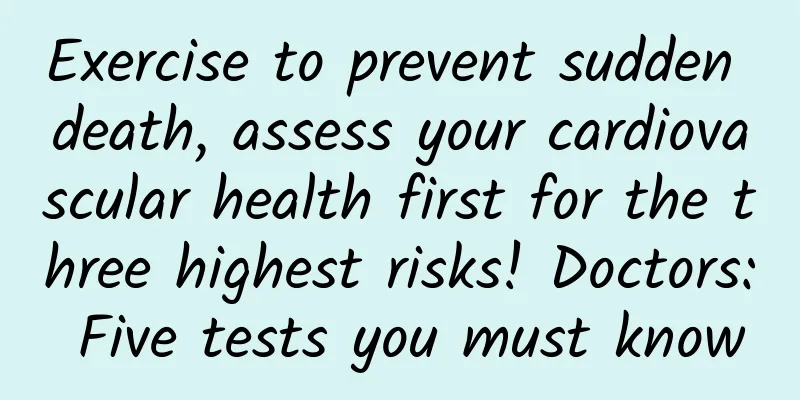Exercise to prevent sudden death, assess your cardiovascular health first for the three highest risks! Doctors: Five tests you must know

|
Cases of sudden death in the gym or during a marathon are not unheard of. Although everyone knows that exercise is good for the body, few people understand how much exercise intensity the body can withstand before exercising. Therefore, this is why we often see reports of sudden deaths when people are running marathons or exercising in the gym. The causes of sudden death due to exercise are mostly heart or blood vessel problems, and patients with chronic diseases are a high-risk group. Dr. Shi Yi-chung, director of the cardiology department at Lian-An Clinic, a preventive medicine institution, said that exercising more is a good thing, but it is best to have a health check to understand your physical condition in order to avoid unfortunate events. The following high-risk groups should pay special attention: Exercise to prevent sudden death, high-risk groups should pay attentionHeart problemsAbnormal cardiac structure: such as hypertrophic cardiomyopathy, left ventricular outlet stenosis, aortic valve stenosis, etc. Suffering from fatal arrhythmias: such as long QT syndrome, Brugada syndrome, sequelae of myocarditis, old myocardial infarction or severe electrolyte imbalance, etc., which can induce ventricular tachycardia or even ventricular fibrillation and other fatal arrhythmias, leading to sudden death. Long QT syndrome, the full name of which is prolonged QT interval syndrome, is a heart disease related to heart rhythm or cardiovascular disease. People with life-threatening heart arrhythmias may die suddenly after exercising. Vascular problemsThe main problem with blood vessels is acute coronary heart disease, also known as acute myocardial infarction. In addition, cerebrovascular infarction (infarction stroke), aortic dissection, cerebral hemorrhage (hemorrhagic stroke) are also conditions that require attention. Taking aortic dissection as an example, since blood pressure will physiologically rise during exercise, if the blood vessels are hard and lack elasticity, aortic dissection may occur due to fluctuations in blood pressure during exercise. chronicPeople with chronic diseases, such as diabetes, hypertension, and hyperlipidemia, are actually a group of people who need attention. If their conditions are not well controlled, they will be a high-risk group for coronary heart disease, so they must be cautious. People who lack exercise habits and have chronic diseases should be more careful to avoid sudden high-intensity exercise. It is best to be evaluated by a doctor and have regular health checks. Under the condition of good control of chronic diseases, gradually increase exercise time, intensity and frequency to safely achieve the goal of good health. Shi Yi-zhong also reminded that sometimes heart problems may be caused by drug interactions, especially some fatal arrhythmias, which are caused by taking certain antihistamines and certain antibiotics at the same time. Therefore, if you are seeing doctors from different departments at the same time, be sure to tell them what medications you are taking. Evaluate your cardiovascular status, 5 major tests to tell youShi Yi-chung reminded that, in fact, the probability of sudden death caused by exercise is not high, but since there are usually no signs before it happens, it must not be taken lightly. It is best to have a health check in advance to find out whether there are any congenital or acquired abnormalities in the heart structure, blood vessels, or cardiac electrical conduction, so as to avoid acute cardiovascular risks caused by exercise. The following analysis recommends five tests to assess cardiovascular status. It is recommended that people should undergo a complete assessment before the age of 45. However, if there is a family history, the earlier the better. Cardiac ultrasound can be used to determine if there are any abnormalities in the structure of the heart, such as hypertrophy, valves, congenital heart disease, previous myocardial infarction, or problems with the size of the ascending aorta. 1. Blood test: It can understand the values of various risk factors for coronary artery diseases, and evaluate lipoprotein patterns, whether there is abnormal inflammation in blood vessels, etc. 2. Cardiac ultrasound: To understand whether there are any abnormalities in the heart structure, such as hypertrophy, valves, congenital heart disease, old myocardial infarction or the size of the ascending aorta. 3. Exercise electrocardiogram: Exercise is used to assess whether coronary blood flow is blocked, causing myocardial hypoxia. Exercise stimulates sympathetic nerve tension and can also assess whether there is any arrhythmia. 4. Carotid artery ultrasound: To understand whether the carotid arteries that supply blood to the brain have abnormalities such as atherosclerotic plaques or vascular stenosis. 5. Arteriosclerosis meter: detects the degree of vascular hardening through the pulse wave flow velocity, and understands the risk of blood vessels rupturing due to lack of elasticity. Exercise is the only way to maintain cardiovascular healthDr. Shi Yi-chung reminds us that although people with cardiovascular abnormalities do face risks when exercising, it is important to do aerobic exercise regularly if you want to maintain your cardiovascular health. In particular, most people with arteriosclerosis have no exercise habits, which leads to the loss of blood vessel elasticity and further causes blood vessels to burst when exercising. Therefore, don’t confuse cause and effect. It is not exercise that causes blood vessel problems, but inactivity that leads to high risks! Moreover, people who do regular aerobic exercise can improve their heart efficiency and reduce the burden on their heart. It can be said that there are many benefits. Therefore, moderate (time/frequency) and appropriate (intensity) exercise is the only way to maintain cardiovascular health. |
Recommend
Eat this way to lose weight and reduce fat with red bean and tangerine peel soup
[Key Points]: The use of red beans and tangerine ...
What are the more effective tests for hyperprolactinemia?
Hyperprolactinemia refers to a syndrome caused by...
What should patients with adenomyosis do if they want to have children?
Adenomyosis is not unfamiliar to everyone. It usu...
Chang Gung Medical Technology Exhibition invites Yang Junhan and Lu Yen-hsun to appear! Teach you how to prevent sports injuries
At the "Taiwan Medical Technology Show"...
Pelvic inflammatory disease can cause menstrual irregularities
Pelvic inflammatory disease is a very common fema...
Do you know how to care for cervical hypertrophy?
If you want to treat cervical hypertrophy, you mu...
Things to pay attention to in daily life when treating functional uterine bleeding in adolescence
The treatment of adolescent functional uterine bl...
Can a premarital examination reveal a previous abortion? The truth is this
Many young people get pregnant unexpectedly befor...
Causes of uterine fluid accumulation during pregnancy
Uterine effusion is also called uterine fluid. In...
Patients with secondary amenorrhea and breast cancer should eat less fatty foods
In addition to early detection and early treatmen...
Pay attention to these factors that may cause adnexitis
Among gynecological inflammations, adnexitis is o...
Song Joong-ki’s fitness coach teaches you: Stop pursuing thinness, micro muscle lines are popular!
The male god Song Joong-ki has an amazing physiqu...
Several common transmission routes of adnexitis
Adnexitis is a gynecological disease that can be ...
What is congenital absence of vagina?
What is congenital absence of vagina? Nowadays, m...
How to prevent cervical hypertrophy
Cervical hypertrophy is a common gynecological di...









